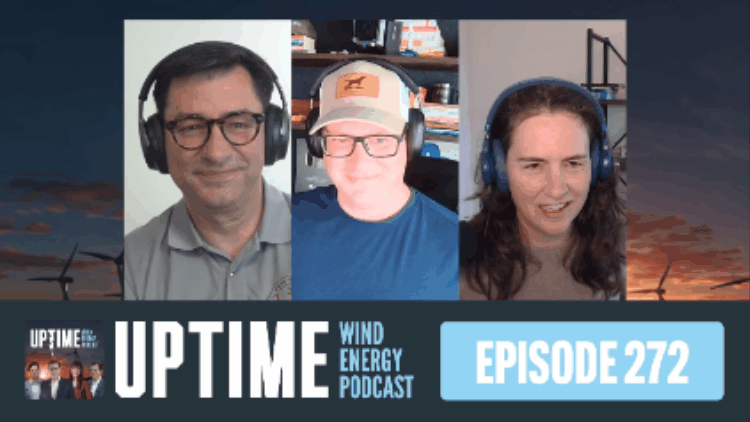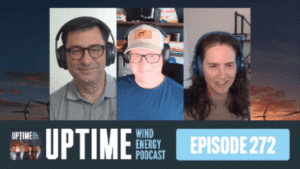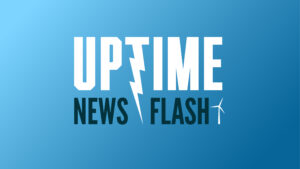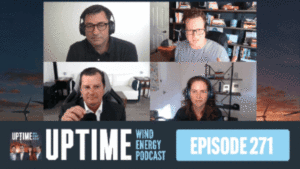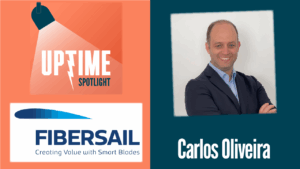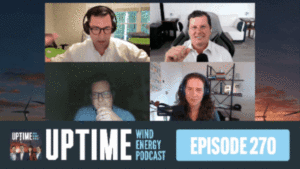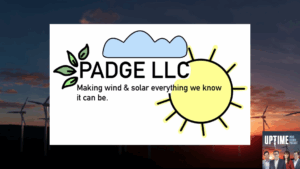Podcast: Play in new window | Download
Register for the next SkySpecs Webinar! We discuss China’s new 20MW floating turbine by CRRC, and Nordex’s patent application for modular blade assembly. Plus HeliService USA’s offshore ambulance service and the recent construction delays at Atlantic Shores and Vineyard Wind.
Sign up now for Uptime Tech News, our weekly email update on all things wind technology. This episode is sponsored by Weather Guard Lightning Tech. Learn more about Weather Guard’s StrikeTape Wind Turbine LPS retrofit. Follow the show on Facebook, YouTube, Twitter, Linkedin and visit Weather Guard on the web. And subscribe to Rosemary Barnes’ YouTube channel here. Have a question we can answer on the show? Email us!
Allen Hall: Our next SkySpecs webinar, if you missed the last one, about lightning protection and how to use SkySpecs, drone imaging and data, and the EOLOGIX-PING Lightning sensor to help yourself on the lightning side. You can actually watch that on the SkySpecs. Just go to SkySpecs and you can see that webinar.
It’s free. All this stuff is free. It’s all great stuff. All you need to do is register. You can get all this information. The next one is coming up on June 25th, 11:00 AM Eastern Time. And this next, webinar is gonna have Liam McGrath from RWE, who’s a blade engineer there, and Tom Brady from SkySpecs, who handles all the cool drone technologies.
So if you haven’t met Tom, you need to go to this webinar and find out what’s going on. And Michael McQueenie from SkySpecs. It’s the rule. Subject is when should you be scheduling your drone inspections and you shouldn’t be doing it in the spring. That’s really important. If you wanna save some money on your operational aspects, your [00:01:00] o and m budget, you need to be thinking about how to get your inspections done, when to get your inspections done, and what tools are available to you at different times a year.
So there’s optimal times to get your drones inspected and there’s suboptimal times. Suboptimal times is like March. Don’t do it, then do it the previous fall. and so Joel will be there. I will be there. Don’t miss it. It is June 25th. 11:00 AM and you can sign up in the show notes below.
Speaker 2: You’re listening to the Uptime Wind Energy Podcast, brought to you by build turbines.com.
Learn, train, and be a part of the Clean Energy Revolution. Visit build turbines.com today. Now, here’s your hosts. Alan Hall, Joel Saxon, Phil Totaro, and Rosemary Barnes.
Allen Hall: Welcome to the Uptime Wind Energy Podcast. I have Joel Saxo along and Rosemary Barnes from Australia and I’ve. Just been digging through all the news over the last several days.
Really disappointing news to the United States, but over [00:02:00] in China. TRRC has unveiled a 20 megawatt floating wind turbine, and it’s, has a rotor diameter of 260 meters, which is not really outrageous. The CRRC press release, which is a little outrageous, let, me read you some of this, and it’s called The Key Hung.
wind turbine, the key Hung, integrates multiple innovative control technologies offering four core advantages. High intelligence system, modularization, full chain collaboration. And Joel, don’t we all want that? And exceptional stability. It incorporates various intelligent controls, sensing and detection technologies that design further enhances the unit’s flexibility and efficiency by modularizing key system interfaces and structural components.
So there are a lot of words in this press release, but they don’t say, actually say anything at all. So that’s why we have Rosemary here to suss
Joel Saxum: out.
Allen Hall: What is happening with CRRC and a [00:03:00] 20 megawatt floating turbine? Is it really needed, Rosemary?
Rosemary Barnes: Yeah, I think I’ve made my thoughts clear about the, like bigger, kind of pursuit of, offshore wind turbines.
And I think that a lot of it is about prestige to be the, first with the biggest. and so I guess that this is the, first with the biggest, floating offshore wind turbine. I, yeah, I don’t think that we’re really ready for, that with floating offshore wind. Floating offshore wind is still in the period where we’re trying to figure out what are the really important design requirements.
How are we gonna deal with some special, issues that floating offshore wind finds. So if you combine all of that with floating offshore wind, or there’s all the, like the, yeah, the floating platform, the mooring mechanisms, control systems, any weird aerodynamics that are happening because of slight tilting or whatever.
There’s all that sort of stuff. It’s still being, learned about. [00:04:00] And at the same time, you’re gonna combine that with all of the really huge blade, really huge turbine problems. I, think that. It’s a little bit crazy if this is intended as, being a commercial offering, it’s probably not, it’s probably a learning exercise and a publicity exercise more than that.
And, maybe from that point of view, like if you go into it trying to learn everything that you can about what would happen if we, eventually go this big, then I guess that there’s some value in that. but yeah, I, don’t think that we’re ready for, just rolling out thousands of these off the end of a production line.
Joel Saxum: Yeah, if you, I’m of course not an expert in Chinese maritime, GE geology. Sorry. But, there’s not a whole lot of super deep water right off of the Chinese coast. The Chinese coast is all 200 meters, like in every place that you’d put like a max step in every place that you’d put a wind turbine.
So if this was to be built for a, a [00:05:00] larger. Rollout. Where is it to sell to? Brazil? Oh, Brazil. Sure. Brazil. That would make sense. That could be right. but I don’t think, like if, China has very ambitious wind goals. And of course if you watch the. Any kind of news, you can see them rolling out large wind farms, left and right, onshore, offshore, all kinds of stuff.
But I don’t think they actually need the floating technology to be honest with you. So it might just be a show of force.
Rosemary Barnes: And also depths of 200 meters, that is challenging or maybe that’s, I think that exceeds the current, maximum depth of fixed bottom, you could get there, but it, uses heaps of steel, the fixed, bottom, Yeah, design compared to what we assume that floating is gonna eventually achieve it. It should use less steel. But it’s funny because that’s one constraint that probably China of all countries doesn’t really have because they have this, like glut of, steel in China or they’re winding down with their, their construction.
[00:06:00] industry. So they have an oversupply of steel. a lot of countries are experiencing China, selling their steel, into those countries at really cheap prices as tariffs around the, world, not, just from the us. and in fact, the US tariffs on Chinese steel predate the Trump administration.
yeah, I, think that. Steel is one thing that China doesn’t have a huge short supply of. I would agree with you that this probably isn’t primarily aimed at their own domestic market. It’s probably more to do with the fact that China has dominance in, every, or at least nearly every energy technology at the moment.
And looking forward if floating offshore wind is gonna grow, then they probably wanna maintain, wanna be dominant in that as well. But I think the main markets that you see talked about for floating offshore wind, yeah, South Korea and Japan, some other, places around that area where they don’t [00:07:00] have a lot of good, renewable resources they can exploit.
And then there’s quite a lot of interest in Europe as well, probably as much because they’re just, really aggressive with their, renewable plans in general.
Joel Saxum: Just to highlight the difference between Western countries and how China operates. One of the things they brag about in this press release is the fact that CRCC, the China Railway Construction Corporation, that single entity is saying, we have a complete wind power equipment supply chain, as in we don’t need anybody else.
We’ve got it all solved ourself, and that’s. Very unique ’cause you’re just simply not gonna have that el elsewhere in the world. now can they execute on that? I don’t know. But it’s an interesting, it’s an interesting take
Allen Hall: and talking of offshore, if you haven’t received your latest PES Wind Magazine, the new edition is out and on the cover is hella service, USA, talking about their ambulance service that they’re offering on the east [00:08:00]coast of the United States.
And we were up there a couple of months ago when we met with everybody. Michael to Paul Russo, Dr. Kenneth Williams, who was with Brown University and had done all their ambulance work there. And obviously Sophie Crane. If you don’t know Sophie, you’re missing out. She’s, she’s really good, with, hella service USA, but they’re offering an ambulance service.
And the thing that Joel, that blew our mind when we were there, and if you can read about it in the article, it says there’s essentially two helicopters that service. The northeast of the United States from the US Coast Guard. So if you flip over your kayak in the ocean, rosemary off the, the coast, New Jersey, it may be a while, it may be several hours where someone can, help you and the US Coast Guard is just gonna pick up your carcass and take it and leave it at the front door of the hospital.
They are not skilled to provide any role paramedic services at all [00:09:00]besides just first aid care. but hella service USA is, it’s a completely different model and it’s, it is still shocking. At Rosemary, we were talking about. Australia, how those helicopters everywhere off the coast of Australia.
Rosemary Barnes: Yeah. any nice day when you could be at the beach in any part of the country, even where I go is the South coast and a lot of people there.
and yeah, you see a helicopter patrolling up and down, checking for any really big sharks, approaching groups of, big groups of people. So definitely we’ve got more than one helicopter for our entire coastline. yeah, it’s, interesting.
Joel Saxum: I think it’s just crazy. Like it’s not something you would think about from, just a general public safety thing.
and or an industrial safety thing, right? Because there’s a whole, there’s a, there’s other stuff going on in the water out there that could be used as okay, I’m gonna switch gears. We’ll go down to the Gulf Coast, F Port Fon out in hoa, [00:10:00]down in Brownsville. Like all of those places that the oil and gas industry has invested in these resources, Boom, that’s there, right? that’s not a problem. it’s a minute phone call. the, it is, however, 180 miles an hour from three minutes from the phone call, you’re gonna be there. And it’s amazing that I would like, I guess I’d like to see the, same thing on the West coast.
What is California, Washington, Oregon, what does their resources look like? ’cause it, just doesn’t make sense to me.
Rosemary Barnes: Yeah, I know. We send, helicopters over to help with bush fires when you have them as well. But I don’t think that’s the same kind of helicopter because we have special ones that can carry heaps of water and then dump just a, whole, bunch of water on a, fire at once.
Joel Saxum: Like you said, the US Coast Guard, they have what’s their specialty bird called? Allen, the Dolphin. They have those, but yeah, they’re not there to be the world’s paramedic. They’re there for search and rescue.
Allen Hall: Yeah. And when we talked about it with, HEA service USA, it isn’t [00:11:00] the technicians and, my thought was a technician would have a broken limb or something really serious.
It could be as simple as appendicitis or an allergic reaction. Peanuts, a peanut allergy where time matters. And before hella service offered this ambulance service, you could end up taking a CTV and it would take a long time for some of these wind farms to get back. To true, healthcare that can really save your life.
So hea service USA is doing a tremendous job on the East coast and elsewhere. They’re expanding their reach as it seems. if you are, new to PS Wind, you need to download a copy of PS Wind, and you can do it@pswind.com. This issue is full of good information. You need to be reading it if you’re going to stay up.
Abreast of what’s happening in wind, you need to be reading PES. Wind.
Joel Saxum: As Busy Wind Energy Professionals. Staying informed is crucial and let’s face it difficult. [00:12:00] That’s why the Uptime podcast recommends PES Wind Magazine. PES Wind offers a diverse range of in-depth articles and expert insights that dive into the most pressing issues facing our energy future.
Whether you’re an industry veteran or new to wind, PES Wind has the high quality content you need. Don’t miss out. Visit PS wind.com today.
Allen Hall: some more bad news for us. Offshore wind is Atlantic Shores, which is a partnership between Shell and EDF renewables. North America has filed to cancel its 1.5 gigawatt offshore wind.
Project off the coast of New Jersey near Atlantic City, the company cited economic challenges including inflation, supply chain disruptions, and the administration’s federal permitting freeze as a primary reasons. Remember, a couple of months ago, the Environmental Protection Agency pulled the project’s air permit, and we talked about that on the podcast.
but it looks like some of these problems are insurmountable, so Shell and [00:13:00] EDF are going to pull the plug. Pulling the plug. Now, Joel doesn’t mean a permanent withdrawal, it just, I think it just means they’re on hold. I’m not a hundred percent sure on that. You still own the lease spot, right? So you still own the plot of ocean.
Joel Saxum: But if you’re going to the, basically the interconnect and saying no, we’re done here. I don’t know. They’re not gonna make it easy to, try to reopen that program. I know EDF laid off a bunch of their offshore people in shell’s, all but closed up their offshore arm. So I don’t see, I can see what, I’ll see if this is my take.
I see Shell and EDF trying to sell this thing, this the lease rights. I don’t know to who, but they’re, gonna take pennies on the dollar for it. But to get something out of it. If
Allen Hall: you think if they waited four years, they have an opportunity to sell it.
Joel Saxum: Maybe the best we’re gonna get is a, maybe. Is that lease, 20?
Is that lease 25 years? What is that lease? Oh, I would assume it’s longer than 25 years. It’d have to [00:14:00] be, but there should be a staged toed construction and then after construction, usually on a federal lease. So I don’t know how long those rights last
Allen Hall: are. Are they still, I guess if they didn’t cancel it, would they still be paying monthly payments to the federal government?
That’s a great question.
Joel Saxum: Or did they pay that in a lump sum?
Allen Hall: yeah. I thought the way the process worked is that they were, they paid the lump sum for the lease, the ability to have a lease, but the lease payments had to be made. And then when the construction started, that ramped up the price of the lease.
Isn’t that how it was laid
Joel Saxum: out? So you get five years and then 25 more. So you have a total of
Allen Hall: 30 years of that spot. So the average tri in life is 20 years. So you still have a couple years to play around here. Maybe that’s what they’re doing.
Joel Saxum: So it says the le the lessee has a period for site assessment, construction and operational planning, and then an operational term of [00:15:00] 25 years.
The initial site assessment period is typically five years, and the lessee must submit progress reports every six months. During this time, after the construction and operations plan is approved, the lessee has an operational term of 25 years.
Allen Hall: So what are our next steps, Joel? Do you think that, It just sits.
Joel Saxum: I think it’s gonna sit, I think it’s gonna sit, it’s gonna sit empty and naked and it’s gonna be a sore spot. there’s, there wasn’t anything out there before. But either way, it’s, economic opportunity that’s on the shelf. I. That’s really sad, right? There’s a lot of jobs from that.
if you went and we went back, if we go back and look at all the things when offshore windows coming, how excited along the East coast, all these governments and agencies and people got about all the jobs coming in, all the economic, stability coming in. All this money that the, supply chain companies that sprout it up and or built facilities or expanding facilities for.
Everything from steel to transport, logistics. [00:16:00] and now it’s just kind of me that’s not a very good American story.
Allen Hall: So moving north a little bit to vineyard wind, vineyard wind has extended its lease of the new Bedford Marine Commerce terminal through June, 2026, suggesting construction delays beyond the original.
2024 Now, 2025 completion date. The, project currently has four turbines sending power to Massachusetts out of the plan, 62 turbines at least, roughly 25 more bar trips are needed to complete construction, not counting the potential trips to remove, blades from, the Canadian factory. The, project has obviously faced some additional challenges lately, but I think.
GE was really hoping to finish that project, I thought this year, but it looks like it’s gonna roll in at least in, at least to early 2026. It’d be my guess. But if they [00:17:00] plan it out to June of 2026, like the, winter months in Massachusetts, south coast of Massachusetts are terrible. so I guess it gives them a couple more, more months to, to clean up at the end, right?
Joel Saxum: Yeah, absolutely. this is a big project, right? And any large capital project is gonna have delays. The delays for this thing have been very public, right? We know when they had stop works, go on up there, we know when they had some blade issues. and then of course having to dismount some blades, send them over to France, I believe it was to get fixed, send back.
yeah. if you follow offshore wind, almost every large project, every offshore wind project has delays, right? They’re usually never on schedule. it’s pretty rare and it’s just the nature of the marine operating environment. Oil and gas projects are the same way. You might, you can get a thing in there, ah, we’ll plan for, 20% weather and then all of a sudden you get two weeks straight of winds where it’s [00:18:00] blowing up the, heat we call, call the heave height, blowing up the waves too high.
You can’t operate. And it is as simple as that. Anybody that works in wind, even onshore, knows that, right? You can have a crane sitting on site for two weeks where you’re sitting there with twiddling your thumbs underneath the crane. ’cause, as soon as eight and a half meters per second of 10 minute average wind speed blows up.
You can’t move the dang thing. and you’re just stuck. So these things happen. They’re looking forward, 2026, so we should be done. Then
Allen Hall: the positive note is that they didn’t shut down the effort early, right? They would say they were gonna abandon it. They’re not gonna abandon it, they’re gonna complete it, which is great.
Massachusetts really needs that energy. Don’t let blade damage catch you off guard. OGs. Ping sensors detect issues before they become expensive. Time consuming problems from ice buildup and lightning strikes to pitch misalignment in internal blade cracks. OGs Ping has you covered. Their cutting edge sensors are easy to install, giving you the power to stop damage before it’s too late.
Visit eLog [00:19:00] ping.com and take control of your turbine’s health today. I was perusing the patent application database from the US Patent and Trademark Office. And honestly, who doesn’t do that in their spare time. And I noticed that there was a patent application, and that’s where all the cool technology is.
Don’t look for patents, look for patent applications, because that’s the latest and greatest. but there was a patent application from Nordics. For a modular blade assembly system, IEA two piece blade. And this approach, is a little bit different than what we’ve seen on the LM side for a two piece blade.
The LM design is a hole and a pin approach to connecting two pieces together. So it’s a relatively simple system that, that LM pursued. And I don’t wanna speak for Rosie, but I think Rosie thought. Do I really need it? is, wasn’t that the sort of summary of what the LM two piece blade output was?
Rosemary Barnes: Two piece [00:20:00] blades in general? it, it sounds like a very appealing thing because blades are very long, they’re hard to transport. They often require, road closures and choosing route carefully to make sure that you don’t have to, go around any tight corners or anything like that. So it sounds very appealing, but they’re inherently very challenging because.
the, a wind turbine blade is basically like a cantilever beam, and they use composite materials which rely like they’re very strong and stiff for their weight because they’ve got these long fibers and loads are transmitted along in the direction of those fibers. Yeah. So if you make a two piece blade, you necessarily cut, those, all those fibers in half in one, in one place.
so that’s challenging. And then if you try and look for, solutions to that. You want to, you need to be able to make the joint strong enough, but not add so much extra weight. And basically the way that a wind turbine blade is loaded, [00:21:00] it’s quite lightly loaded towards the tip. But then as you get to the root, all of the The moment forces from, the, the outboard section of the blade, they add up. So the biggest loads are at the root of the blade. So basically, if you wanna make your structural problem easier with a two piece blade, you’ll split it close to the tip. But then what’s the point in that? what you would obviously want to do is split it in the middle or thereabouts.
But that means, huge loads have to be transmitted through your pin joint, or whatever kind of joint that you had. And so it’s just inherently very challenging to do that.
Allen Hall: And that’s where the Nordic patent application, takes a different approach than what LM did. They basically have a sleeve design and a bolted design.
A hydraulics are used to pretension this joint. The images are a little unclear to me as an electrical engineer having [00:22:00] never built a two piece blade, but it does sound like they’re trying to address certain, mechanical loads in different ways. So like the, sleeve assembly is there, to react to the bending moments, and then the actual loads are handed through this threaded connection.
And then the pretension gets rid of any sort of fatigue problem, so they preload it. It’s a different approach, but the, I think the, cost benefit, at least from the application, says it will reduce transportation costs from roughly a hundred k, per blade to about 40,000 because you can put on a, basically a standard truck and, move them around, which is always the.
The emphasis on these two piece are now three piece. I guess it could be three pieces, blades from a application standpoint. Rosemary, this is a mechanical joint. It would seem like a lot of mechanical joints have been dealt with, but maybe it’s because it’s such a large [00:23:00] composite structure, this particular kind of mechanical joint have never been conceived of.
Is this something that, that, you have seen before, but it has been set aside for other reasons? Cost reasons.
Rosemary Barnes: Yeah, I haven’t seen something exactly like this one. If you look at the sketches in the patent application, then you do see a lot of details that are trying to spread loads over a, a wider distance.
So it’s not trying to have, just this one narrow joint where all of the loads need to be transferred. However, there you are adding a whole lot of extra components to, a wind turbine blade and. it is really, it’s very challenging because they’ve got, millions and millions of fatigue cycles that these, blades have to deal with.
really high strain compared to any other kind of, structural component in a, different industry, a different application like this. This is really the hardest, the hardest example of, those kinds of [00:24:00] loading conditions. So it’s still, you’re still definitely going to be, either reducing fatigue performance or adding a, weight penalty and probably both.
so I, yeah, I, doubt that it’s a, perfect solution. Obviously they’ll develop as far as they can. It’s also worth noting that, so they can put it on a normal truck for, what is this, for three megawatt. Roughly turbines. Yeah, it, the blade length isn’t the only thing making transport of blades expensive.
So as you get much bigger than three megawatts, then you start to get a quite a large root diameter. And that is also a, constraint. You then you need to worry about getting under bridges and stuff like that. So it’s not the. It’s not the only thing, and it’s not gonna be like, oh, now we can transport 12 megawatt blades with 12 megawatt turbines on shore easily.
it’s definitely not gonna be that. So
Joel Saxum: are you talking about this root diameter [00:25:00] thing from the latest, Australian newspaper article? We saw
Rosemary Barnes: the one, I think there was a turbine, a tower segment. that got stuck under,
Joel Saxum: stuck under a bridge, I thought. Was that a tower segment? I thought it was the, for some reason I thought it was the root end.
Rosemary Barnes: The report reporting was terrible. it, like it and mentioned you just need to look at it to be like, oh, there’s a door on there. Okay. Yeah, it’s a, tower segment. and probably the bottom one. Yeah. And I, back to the split blade thing and whether it’s worth it, I guess that’s the thing, like it’s a solution to a problem.
Is the problem severe enough that the difficult solution is worth it? That I think is extremely debatable. So in the end, I think with the GE split Blade Cyprus, I don’t think that they sold any additional projects that they wouldn’t have been able to sell without this, split blade. That’s the word on the street.
if it’s true that you can reduce the transport cost by that much, then that would be very interesting. But I personally wouldn’t be rushing to be one of the first [00:26:00] people to get this blade because there’s so, much that can go wrong with it. And it is. Not possible to test, act absolutely every, little quirk of the operating environment.
You, you can’t test that all in the lab adequately to be totally sure that the first ones out in the field are gonna. Be reliable. yeah, I would wanna see, I would wanna be, like turbine 1000 after a few years experience before I, put, placed an order for my own wind farm, I think.
Joel Saxum: Yeah. One of the things that we saw with that existing two place, two piece model out in the field right now, the Cyprus, is that, there’s a couple of things, right?
There’s, the seal hasn’t been sealed quite right, but a lot of it boils down to. The technicians in the field that are putting these things together like they’re Desi, that joint was designed to be put together by high-end engineers in a factory.
Rosemary Barnes: It’s not their, it wasn’t their intention. Certainly everybody knows that you’re not gonna send an engineer around for every single blade that’s gonna be put [00:27:00] together,
Joel Saxum: but they, I’ve talked firsthand at people that are installing ’em in the field and they’re like.
We don’t really know how to put these things together. We’re just doing it.
Rosemary Barnes: Yeah, it wasn’t an easy, and that term poke yoke, it’s supposed to be poke yoke, that there’s only one way that you can install it. there’s no chance to get it wrong and it didn’t quite achieve that.
and I would suggest that. Yeah, looking at the, complexity in the design in these patents, I don’t think that’s gonna be totally straightforward to, install and, maintain and monitor. ’cause you shouldn’t have to monitor, your, blade to know, oh yeah, these. pins shaking loose and it’s gonna fall apart.
are you getting up there on rope every single year or six months to check the talk? that’s, really, you’re gonna burn through your transportation saving pretty quickly. But, if you have to get extra rope access inspections every year, so yeah, I think interesting.
I’m actually [00:28:00] not, sure if we’re ever going to see the split blade thing fulfill its potential. ’cause I do think that there’s other solutions to. To the transport issue. we already have them, right? They, cost a little bit more. But then, like I, I could imagine more likely that we’re gonna see, on, on site, manufacturing of blades or, thermoplastic blades that get welded together on site.
Or like I, I can see. Other things. Alan’s making airplane wing motions, big airplanes. No way. Come on.
Joel Saxum: Okay, so this week for the Wind Farm of the Week, I may or not, I may, I am gonna get some words wrong here because we’re taking a trip over to the Netherlands. This conversation started with a friend of mine, a friend of the show, Lars Benson, up in Canada, and we were talking about offshore wind in the Great Lakes.
Why not? There’s great wind resource. There is a need for renewable energy in places that can’t get a lot of renewable energies. Say like up [00:29:00] in Lake Superior for Wisconsin, the Univer or the Upper Peninsula of Michigan and other things like that. So we were talking about fresh water, wind farms. Is there any in the world?
What are the challenges they have? Turns out Wind Park Free Salon is the largest freshwater offshore wind farm in the world, and it’s in the Netherlands. so yeah, and it actually has over 380 megawatts in size. I didn’t know this. I didn’t, think any of ’em existed. There’s 89 Siemens Cesa, SWT Direct Drive, one 30 turbine.
So they’re 4.3 megawatts a piece, and they’ve laid ’em out in a hexagonal kind of shape. And this was to ease the, view of the eye and some other things for, the local considerations. And they dove in headfirst, local considerations. They did all kinds of things to make this a. A joint effort between the community and the developers.
one of the cool things they did was a lot of local sourcing local welding firms for making steel platforms, that [00:30:00] brought in other people that will have work for the lifetime of the wind farm, which is great. 720,000 euro per year for 20 years. Environmental fund that’s gonna be built by this wind farm.
another really cool one, a citizen investment. so the Province of Free Salon offered bonds to residents enabling them financial participation in the wind farm, so you could invest in it and take dividends from the wind farm as it produces energy, which I think is a really cool concept. but this one I think is one of the, one of the neatest ones ’cause I haven’t heard of this yet.
despite the initial fears of a tourism decline, the Wind farm has introduced new activities like the Windmill Cup. Which is an annual sailing race through the turbines organized by a local water sport association. Really? Yeah. I didn’t, never heard of any of this. Over in the Netherlands.
Congrats to our friends there for the, largest fresh water offshore wind farm in the world. And we hope we can draw on that over [00:31:00] here in the States. So for the Wind Farm of the Week, wind Park Free salon over from the Netherlands.
Allen Hall: Wow, that’s amazing. Thanks Lars for that tip. That’s really cool. that, that’s gonna do it for this week’s uptime Wind energy podcast.
Rosemary will be back next week, Joel. Are you coming back next week or? I
Joel Saxum: believe so,
Allen Hall: yeah. we’d love to have you. it’s an open invite. You can come and go as you wish, and we’ll see everybody here back next week. and thanks to all the listeners and everybody on YouTube. Our, listenership is just exploding and we appreciate everybody who’s listening and we’re trying to bring you all the latest news and technology around wind industry.
Around the wind industry and we appreciate everybody contributing and sending us notes, including Derek Rutherford. So thanks Derek, for sending us a couple notes here about what’s happening in wind and we’ll see you here. Next week on the Uptime Wind Energy [00:32:00] Podcast.



